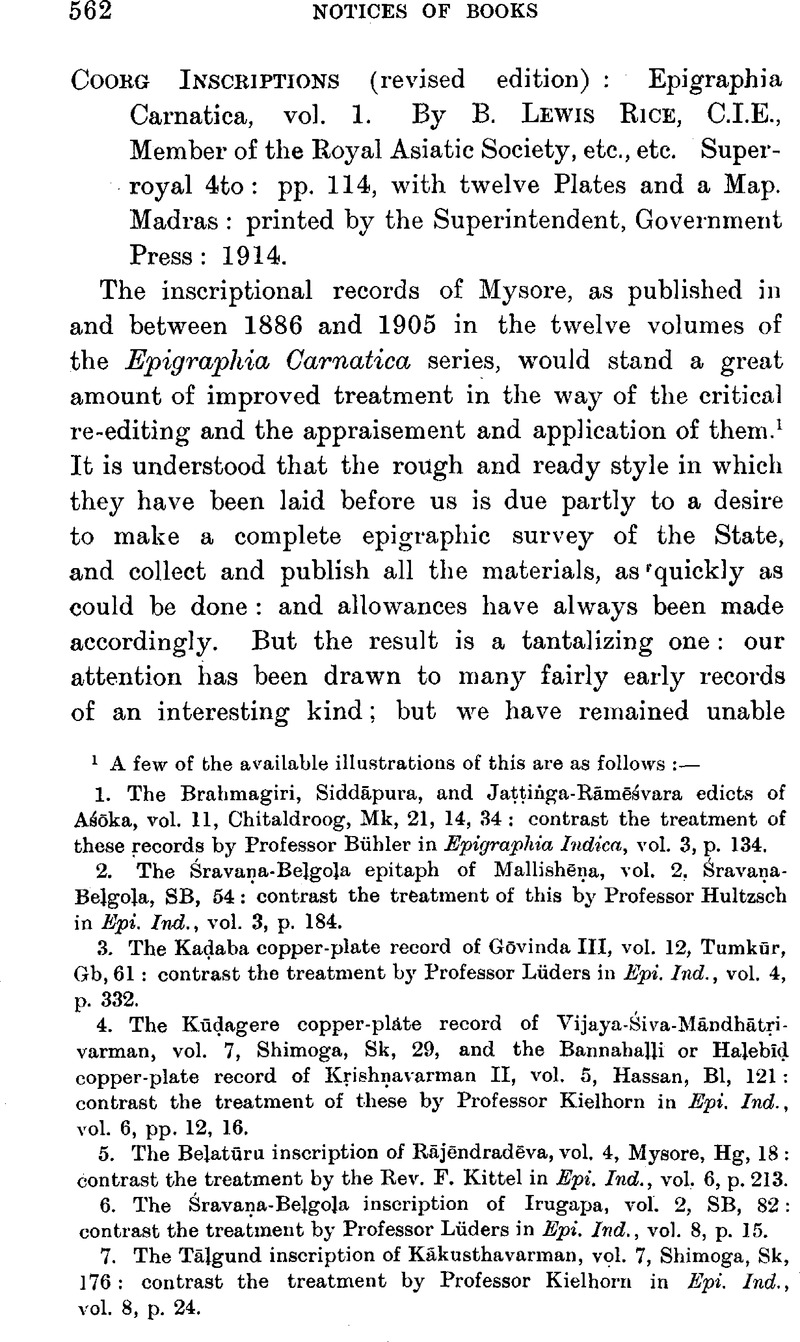No CrossRef data available.
Published online by Cambridge University Press: 15 March 2011

page 562 note 1 A few of the available illustrations of this are as follows:—
1. The Brahmagiri, Siddāpura, and Jaṭṭiṅga-Rāmēśvara edicts of Aśōka, , vol. 11Google Scholar, Chitaldroog, Mk, 21, 14, 34: contrast the treatment of these records by ProfessorBühler, in Epigraphia Indica, vol. 3, p. 134.Google Scholar
2. The Śravaṇa-Beḷgoḷa epitaph of Mallishēṇa, , vol. 2Google Scholar, Śravaṇa-Beḷgoḷa, SB, 54: contrast the treatment of this by ProfessorHultzsch, in Epi. Ind., vol. 3, p. 184.Google Scholar
3. The Kaḍaba copper-plate record of Gōvinda, III, vol. 12Google Scholar, Tumkūr, Gb, 61: contrast the treatment by ProfessorLüders, in Epi. Ind., vol. 4, p. 332.Google Scholar
4. The Kūḍagere copper-plate record of Vijaya-Śiva-Māndhātṛivarman, vol. 7, Shimoga, Sk, 29, and the Bannahaḷḷi or Haḷebīḍ copper-plate record of Krishṇavarman II, vol. 5, Hassan, Bl, 121: contrast the treatment of these by ProfessorKielhorn, in Epi. Ind., vol. 6, pp. 12, 16.Google Scholar
5. The Beḷatūru inscription of Rājēndradēva, , vol. 4Google Scholar, Mysore, Hg, 18: contrast the treatment by the Rev. Kittel, F. in Epi. Ind., vol. 6, p. 213.Google Scholar
6. The Śravaṇa-Beḷgoḷa inscription of Irugapa, vol. 2, SB, 82: contrast the treatment by ProfessorLüders, in Epi. Ind., vol. 8, p. 15.Google Scholar
7. The Tāḷgund inscription of Kākusthavarman, , vol. 7Google Scholar, Shimoga, Sk, 176: contrast the treatment by ProfessorKielhorn, in Epi. Ind., vol. 8, p. 24.Google Scholar
page 563 note 1 Compare the preceding note: other instances, perhaps as many as twenty, might be cited; but that is all.
page 563 note 2 This is stated in the preface: and the book, in addition to being vol. 1 of the Epigraphia Carnatica series of Mysore, is also marked as vol. 39 of the New Imperial Series of the Archæological Survey of India.
page 563 note 3 Coorg is a British Province: but the Chief Commissioner who administers it is the Political Resident of Mysore: hence the inclusion of the inscriptions of Coorg in the volumes of the Mysore series.
page 564 note 1 This table, which is indispensable towards enabling us to follow the published disquisitions, still remains to be made fully useful at a glance by rearranging the entries in the exact alphabetical order of the abbreviations themselves, instead of that of the full names of the tāluqs which they represent. Also, the titles and dates of issue of the twelve volumes, which should always be given along with it, would have been given better here, below this table, rather than in the separate list on p. 102.
To make it really easy to turn to the texts and translations of the records, the numbers of the volumes should be quoted along with the abbreviated references, as, for instance, “2, SB, 54”, “5, Bl, 121”, “7, Sk, 176”. Further, in any revised edition of vols. 3 to 12 the taluqs (after that one which has the same name with the district which gives the title of the volume) should be rearranged in alphabetical order. As matters stand, it is hard to think of any references more difficult to turn up than those to the contents of the volumes of this series.
page 565 note 1 See disquisitions in the introductions of other volumes of the series (especially vol. 9, Bangalore), of which only an outline is given on p. 3ff. of the introduction to the present book. For some of the other forgeries so used, see the present writer's List of Spurious Indian Records in Ind. Ant., 1901, p. 214Google Scholar, Nos. 10, 11, 46, 48, 50 to 52, and 54 to 59. Others are to be found in volumes of the Epigraphia Carnatica and Annual Reports published after the date of that list.
Along with the spurious records, much use has been made of some inscriptions of the eleventh and twelfth centuries which present matter of a purely fabulous nature relating to early times: see remarks by the present writer in JRAS, 1905, p. 295 ffGoogle Scholar. Also of certain imaginative chronicles, one of which was composed as late as the nineteenth century: regarding the most notorious of these, the Kongudēśarājākkaḷ, see some remarks in Epi. Ind., vol. 3, p. 170.Google Scholar
page 565 note 2 For an illustration of this method see any volume of the Epiyraphia Indica, in particular from vol. 3 onwards.
page 566 note 1 This remark applies to the texts in roman characters, which are the important ones. The omission is the more extraordinary because (1) the lines have been duly marked in the Plates, which, however, is of no practical use unless the texts are arranged to match; (2) they actually are shown in the texts in Kanarese characters (p. 73 ff.), which, however, are of no use for purposes of reference.